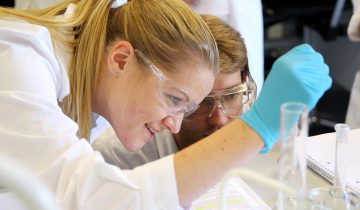By Roberta Attanasio, Forever Leaders Editor
The authors of an article published a few months ago in the scientific journal PLOS Biology (The gender gap in Science: How long until women are equally represented) examined the gender gap in the Science, Technology, Engineering, Mathematics, and Medicine (STEMM) workforce, and stated that “Despite recent progress, the gender gap appears likely to persist for generations, particularly in surgery, computer science, physics, and maths.” They conclude that the STEMM gender gap will not close without further reforms in education, mentoring, and academic publishing
Therefore, more needs to be done to reach gender equality in the sciences. In a recent FEBS Network blog post, Laura Norton wrote: “For science to flourish and progress we need a diversity of inputs and talents. If we’re all the same, if we think in the same way, our science will be limited. The huge challenge of understanding the world around us demands input from different approaches. Contributions from all genders are vital to create an inclusive and motivating environment that science and each individual will benefit from.”

Photo credit: rawpixel on Unsplash
During the US symposium for Elsevier’s Gender in the Global Research Landscape, Rita Colwell, Chair of the National Academies of Sciences, Engineering, and Medicine Committee on Women in Science, Engineering and Medicine, called on support for the social and behavioral sciences to continue investigating the issues facing the advancement of women in science, and to generate the data needed to drive cultural and policy change for global gender equality. She quoted Dr. Marcia McNutt, Director of the National Academies of Science: “Science without policy is still science, policy without science is gambling. We can’t afford to gamble.”
Accordingly, U.S. funding agencies are committed to bringing gender equality to STEM and, for the past several years, have implemented gender-diversity programs. One of these programs, the National Science Foumdation’s ADVANCE, is designed to foster gender equity through a focus on the identification and elimination of organizational barriers that impede the full participation and advancement of all women faculty in academic institutions.
“The goal of the National Science Foundation’s (NSF) ADVANCE program is to increase the representation and advancement of women in academic science and engineering careers, thereby contributing to the development of a more diverse science and engineering workforce. ADVANCE encourages institutions of higher education and the broader science, technology, engineering and mathematics (STEM) community, including professional societies and other STEM-related not-for-profit organizations, to address various aspects of STEM academic culture and institutional structure that may differentially affect women faculty and academic administrators. As such, ADVANCE is an integral part of the NSF’s multifaceted strategy to broaden participation in the STEM workforce, and supports the critical role of the Foundation in advancing the status of women in academic science and engineering.”
As ADVANCE continues to be implemented all around the country, is there evidence that the program benefits more than just the women faculty involved? To address this question, researchers at Montana State University—over the course of 3 years—collected data from male and female tenure-track faculty members across disciplines who felt involved in one of the ADVANCE programs. This specific program was designed and implemented around Project TRACS, comprised of three initiatives: enhancing research capacity and opportunity, enhancing work-life integration, and enhancing cultural attunement.
The researchers assessed universal psychological needs: make meaningful connections with others (relatedness), have flexibility and choice over processes and outcomes (autonomy), and feel efficacious in mastering their environment (competence). Together, these three psychological needs are thought to form the basis of human motivation. When these needs are optimally satisfied, people experience “self-determination.”
The researchers found that—for everyone, regardless of gender or field of study—involvement in the program predicted a significant positive change in overall feelings of autonomy, competence, and relatedness and, therefore, predicted satisfaction of universal psychological needs. In addition, this change was associated with positive changes in job satisfaction over time among all faculty.
The researchers concluded that it is possible to focus on faculty diversity, equity, and inclusion in ways that have wide-spread positive impacts on all who feel involved.
Copyright © 2016-2018 Forever Leaders.




Women are labeled to be the “inferior sex” which leads to gender inequality in STEM. I feel that the ADVANCE program should be implemented to enhance the lack of diversity in the medical industry; however, there must be an adjustment to accommodate every woman. The STEM field needs to be more feasible for people with different ethnic backgrounds, disabilities, socioeconomic status, and sexual orientation as well. A possible reason why there is a lack of women in STEM is because of the lack of financial resources in this field. According to the American Institute for Research, the STEM program cost at the maximum rate of $60,000. I believe that the ADVANCE program should acquire funding from various sponsors to give women a chance to pursue education and to eradicate financial barriers. As a minority, the ADVANCE program should welcome everyone and encouraged them that their voice matters. In addition, a disability should not impede or dictate one’s potential. It is not right that people with disabilities are being overlooked or ignored. There is a lack of diversity in the STEM and it is troublesome to realize that 43% of women leave this field for a part-time job or to be a stay-at home mother. My question to this statistic is “Why can I not succeed in my career and in my household?” I am a strong advocate that not only women can be a successful entrepreneur but can be a powerful matriarch as well. The ADVANCE program would be stronger if these underlying issues were solved in the STEM field to give women the chance to have a voice in regard to the infectious pathogens that cause excessive pandemics and infect public health currently. Science is a universal language and should include everyone from different backgrounds, ethnicities, and races .
It is wonderful that there are programs like ADVANCE that are dedicated to addressing the lack of diversity in STEM. I agree with Nuria saying that increasing diversity allows more points of view to be heard which enriches academia by being able to see things from all angles. However, it is also important to address the barriers that may keep women out of school in the first place such as the feminization of poverty. The pay gap between men and women has globally caused the proportion of women to men who are caught in the cycle of poverty to grow. Careers in STEM are notoriously known for requiring a lot of higher education, which can be very costly, especially here in the United States, so it may be harder for women to pay for that education, especially if they come from women-headed households. Therefore the solution to increasing diversity in STEM may partially lie in remedying financial barriers that keep women out.
I agree with Titilope. This program is a geat idea and should be extended to include other minorities including, people with diabilities, sexual orientation, low income, and other groups of this nature. The program has the right idea that when differences are welcomed, then more growth in the science field will occur as a result. I thik programs like this should be encouraged everywhere and even if they do not meet their goal, they should find ways to tweak the system and not just give up on the idea. I would laso like to add that programs like this should be offered at younger ages because by the time they reach college age, many people that do not fit into the steretypical scientis look wil have lost hope. Starting this program at a young age will do alot of good.
The existence of this program is definitely a step in the right direction, however, I’d be interested to see exactly how institutional barriers are being addressed through the ADVANCE program. Are a certain number of research opportunities being granted specifically to women on account of their gender as a form of affirmative action/positive discrimination? How do you enhance work-life integration? Are institutions that have implemented ADVANCE hosting workshops and seminars educating their employees on cultural attunement as a way to help people recognize their own biases? Is the presence of the program enough to prompt company leaders to seek their own individual solutions to these issues? I’m curious to see the methods by which the STEM community addresses these issues from a policy standpoint. Ultimately I’m happy to see that the need for action has been recognized and that there’s an effort being made; I hope that more institutions embrace ADVANCE or similar programs as a way to help bridge the gender gap in STEM.
There is no denying that gender equality in STEM fields is essential and beneficial. I believe that one of the next and most crucial steps is about adding more racial diversity to STEM fields. As I pursue a career in nursing, I think of recent news reports that black women face more oppression in hospitals. Their needs are disregarded, they are not believed, and they suffer because of it. Black women are four times as like to die from pregnancy complications than white women. To combat this problem, we need more diversity in medicine. We need people from all backgrounds to have the opportunity to become leaders in medicine so that they can better serve and reflect the world we live in.
I think that at many universities people have adjusted to the ratio with both gender and race, and therefore view it as normal. So, if you’re a minority or a female, certain universities may be known to be predominantly one race or gender and you feel as if you’re not wanted. However, programs such as ADVANCE are important because it is taking that first initiative to let others know “you are welcome here.” I feel like as programs like ADVANCE continue to progress, both women and minorities will feel more confident in applying to different programs because they will feel the support. Personally, I never thought I would fit in at Emory University, but their diversity program has given me the confidence to apply and I am looking forward to bringing my cultural values.
While reading this article I was pleased to see that the ADVANCE program was being implemented. As a minority in medicine, I personally believe that it is important that everyone feels included and feels that they are capable of achieving their goals. For me personally, I was hesitant to pursue a career in medicine because I felt I wouldn’t be good enough for the job and someone else would be better. That made me realize that I matter and the care that I would like to do, I can do it. This also made me realize that I can learn something from others. The ADVANCE program should also be expanded to others with disabilities, wheater they are visible or not visible. I feel that broadening this spectrum will have a positive impact on the STEM field and also will show other people in the STEM field that there are others that can do a job just as well as they can.
Wow. I agree with your comment in regards to being a minority often times it is difficult to actually want to be in the science field simply because of being a minority. Being a minority has often times appeared as a disadvantage, but then I realized I have the opportunity to chase after all of my dream and aspirations no matter if I am an African American female. Being an African American female who has an idiopathic condition sometimes it weighs me down because I begin to doubt myself because of others around me, but then I remember it is okay to be different from other people. The ADVANCE program, is an extremely exciting program! I love the fact that you suggest to include people with disabilities. This excites me because often times because of disabilities people leave others out and that is wrong. Thank you for being considerate!
I am glad programs like ADVANCE are being implemented because diversity and inclusion are not enough. Accountability and accessibility to resources that enhance success and growth in a woman’s position are important. However, this should not stop at just closing the gender gap. We need to make the STEM field more accessible to people of varying sexual orientations, non-conforming gender expressions, disabilities, ethnicities, and socioeconomic backgrounds. This should not be done to simply meet a quota but to value the various identities of scientists. Doing so will trickle down to the research they do base on their novel perspectives and concerns. I recently went to the Annual Biomedical Research Conference for Minority Students and I say the abundance of diversity within the STEM community. I also was able to attend sessions and meet with experts within their respective domains. One thing that really resonated with me is the inclusion of people with disabilities. I attended a mentoring session and was able to interact with a civil engineer. Although her profession did not align with my interests, I got some insight on what inclusion really means. She is a black, disabled woman who is a leader in her profession. With her identities, she has had experiences that are valuable to her profession. She was concerned with the accessibility of structures built by civil engineers. She also noted certain explicit and implicit biases in her workforce in relation to race and gender, and she made it a duty to speak out. Having these discussions is important to bring more humanity to the progress made within STEM.
I think you comment is great! As you said, it is important to include woman with different backgrounds, ethnicities, sexual orientations, etc. It also crucial to have programs to increase the participation of people with disabilities in the STEM field. I found that there is a program conducted by the University of Washington called AccessSTEM (https://www.washington.edu/doit/programs/accessstem/overview/about-accessstem-project) which has its focus on making the STEM field accessible for people with disabilities. In order for the STEM field (or any other field) to advance we need the talent and points of view of as many diverse people as possible. Thus, programs like ADVANCE of AccessSTEM not only help minorities or people with disabilities but contribute to the progress of the STEM field as a whole.
I think you bring up a good point. Though ADVANCE is implementing change by its efforts to bring about gender equity in STEMM fields, other barriers for different backgrounds still exist and need to be addressed. You noted that the STEM field should be more accessible to people of varying sexual orientations, non-conforming gender expressions, disabilities, ethnicities, and socioeconomic backgrounds. Socioeconomic backgrounds, in particular, need better access to financial resources, motivation, and inclusion in these fields. In areas with low socioeconomic status getting access to educational resources and overall interest in them is difficult. I believe that it is important that equity and motivation to be involved in STEMM should be addressed to all the barriers. Just by getting involved in these conversations, we are setting the stage for change.
I am so intrigued by this mindset. While gender equality is such an important concept, so is all of the other equalities. As a female, I find myself being more triggered by female advancements, not tending to think about the struggles of others who are even further from the gap than we are. Diversity of all types of people can be so beneficial, but in order to see this bigger picture, we must encourage people from different walks of life to pursue this kind of career if it’s something that they really want to do. Just a few examples at the forefront can catapult a lot of other ideas and actions for people who feel underrepresented to come forward and bridge that gap. While I understand quotas were set in order to promote inclusion, I believe people should be hired by their qualifications and not looked at for a job just because they fit this certain type of criteria. Inclusion of all kinds can put the STEM field on such a fast pace to success.